
Wine Culture and Information since 2002 - Volume 22
 Wine Culture and Information since 2002 - Volume 22 |
|
Comparing SyrahTypical in the Rhône Valley, Syrah is a grape capable of making great red wines, both alone as well as blended to other grapes, recognizable for its aroma of black pepper |
|
Syrah is the most common grape of Rhône Valley, France. Despite its origin is, for many aspects, uncertain - some in fact believe it is from the Middle East - reliable information suggest with this grape were produced wines in the Rhône Valley since the times of ancient Romans. Syrah followed the same destiny of other French grapes - today defined “international”, however French - and from the Rhône Valley it spread in all the wine countries of the world, sometimes changing its name in Shiraz, such as in case of Australia and South Africa. The name Shiraz is sometimes used in other countries as well, such as Italy, however Syrah or Shiraz refer to the very same grape. Despite it is the typical grape of red wines in Rhône Valley, Syrah is frequently associated to the wines produced in Australia, probably introduced in 1832 and that in this country showed since then excellent productive potentials. Syrah is mainly used for the production of mono varietal wines, however its use is frequent for the production of blended wines as well, therefore contributing to the body and aromatic profile of the wine. Frequently used with other French grapes - in particular Cabernet Sauvignon and Merlot - Syrah is also vinified with the local varieties found in the countries in which it is present, such as - in case of Italy - Sangiovese, Nero d'Avola, Corvina and Barbera. Despite the production of Australia makes very interesting wines with Syrah, this grape is mainly associated to the red wines of Rhône Valley, in particular the ones from the appellations of Cornas, Côte-Rôtie, Crozes-Hermitage, Hermitage and Saint-Joseph. As for Australian Syrah - or Shiraz - the best ones are from the areas of Barossa, Coonawarra and Hunter Valley. In the rest of the world, Syrah is common in South Africa - where it is known as Shiraz - and its spreading is becoming more and more important in Italy and California as well.
|
|
Wines produced with Syrah - including the ones produced with the blending of many grapes - can be recognized by the typical organoleptic qualities, in particular, in the aromatic profile. Among the many aromas which can be found in Syrah, the ones being more frequently associated to this grape are plum and black currant, however Syrah is mainly famous for the unmistakable aroma of black pepper. The intensity and cleanliness of black pepper aroma in Syrah depend on the vinification techniques, in particular the type of cask and the type of wood used for aging. Thanks to its qualities, wines produced with Syrah are characterized by a good body - most of the time having a full body as well - a quality which is accentuated with the use of cask which in turn contributes to “smooth” the harshness of the tannins found in this grape. Despite the most common aging technique used for Syrah is the cask or barrique, in some cases producers choose inert containers, such as steel tanks.
The goal of our comparative tasting is to understand the organoleptic qualities of Syrah by evaluating three mono varietal wines coming from three different areas. Besides the different area of production, the three Syrah wines of our tasting have been aged for different periods, although in all the three cases the container used for aging was the barrique. The first wine of our comparative tasting is Casale del Giglio's Shiraz, produced in the area of Latina and aged for some months in barrique. The second wine selected for the tasting is Spadafora's Sole dei Padri produced in Sicily and aged for 12 months in barrique. The last wine is from the Rhône Valley, France: Cave de Tain l'Hermitage's Hermitage Rouge Nobles Rives, aged for 18 months in barrique. The wines of the tasting will be served at a temperature of 18° C (65° F) and, as usual, we will use three ISO tasting glasses.
|
||||||||
|
Syrah is a grape with a high content in coloring substances, therefore its wines will tend to show pretty intense and deep colors, as well as a pretty limited transparency. Color and transparency, just like any other grape or wine, are strongly affected by cultural yields, quality of the grape and vinification techniques. Wines produced with Syrah grapes harvested in vineyards with low yields will always show a deep ruby red color and a very low transparency, frequently impenetrable to light. During the first years, these wines will show purple red nuances, a characteristic that quality Syrah wines will usually keep for some years. With time and aging in bottle, Syrah wines will follow the development usually observed in red wines. After some years, the ruby red color will become garnet red and then brick red, whereas nuances, from purple red, will get a ruby red color and then garnet red, finally brick red. The first wine of which we will evaluate aspect is Casale del Giglio's Shiraz. By holding the glass tilted over a white surface, we will observe, at the base of the liquid mass, the color. It will be observed an intense ruby red color and a pretty limited transparency, because of the content of coloring substances in Syrah. The nuance of this wine, observed at the opening of the glass and still held in a tilted position, will show a ruby red color. let's now pass to the evaluation of the second wine: Spadafora's Sole dei Padri. The wine shows, when observed by holding the glass tilted, an intense ruby red color and nuances of garnet red. Also in this case transparency will be very low, even lower than the previous wine. Let's now pass to the third wine of our comparative tasting: Cave de Tain l'Hermitage's Hermitage Rouge Nobles Rives. Just like the previous wines, also in this case will be observed an intense ruby red color, garnet red nuances and a pretty limited transparency.
|
|
Syrah is used both for the production of mono varietal wines as well as for the production of blended wines with many grapes. Also in case of blended wines, olfactory qualities of Syrah are always well perceptible, in particular black currant and, frequently, the aroma of black pepper. Despite Syrah is frequently associated to the aroma of black pepper - a quality which is however found in other grapes as well - this not, of course, its only olfactory quality. Typical aromas in Syrah directly recalls the ones of fruits - in particular black berried fruits - such as plum, black cherry, black currant, blueberry and blackberry. The world of flowers is mainly represented in Syrah by the aroma of violet. Syrah is a grape rich in polyphenols, therefore the most frequent vinification technique used for this grape is the cask or the barrique. The aging in wood, together with the aging in bottle - which in case of Syrah can also be of more than ten years - wines produced with this grape will also develop tertiary aromas. Among the many are mentioned vanilla, licorice, tobacco, black pepper, chocolate, cocoa and leather, as well as balsamic aromas of eucalyptus and menthol. We will begin the olfactory evaluation of the three wines from Casale del Giglio's Shiraz. By holding the glass in vertical position and without swirling, we will analyze opening aromas, made of aromatic substances whose molecules require a little of oxygen in order to volatilize. The first smell will reveal aromas of black cherry, plum and black currant, three typical fruit aromas in Syrah and that are however common in other grapes as well, such as Cabernet Sauvignon and Merlot. After having swirled the glass, in order to favor the volatilization of aromatic substances made of “heavy” molecules, we will proceed with the second smell. It will be perceived aromas of blueberry, violet, pomegranate, as well as hints of vanilla, carob and the typical aroma of black pepper, not very evident in this wine but however perceptible. Let's now pass to the second wine of our comparative tasting, Spadafora's Sole dei Padri, which, as opposed to the previous wine, ages in barrique for a longer time. By holding the glass in vertical position and without swirling, we will proceed with the first smell in order to evaluate opening aromas. The aromas which will be perceived from the glass are black cherry, plum and black currant: an opening similar to the previous wine, however announcing a higher complexity. After having swirled the glass, we will proceed with the second smell, from which will be perceived aromas of blueberry, blackberry and violet followed by vanilla, licorice, cocoa and black pepper, as well as a pleasing balsamic sensations of eucalyptus. As opposed to the previous wine, Sole dei Padri is characterized by a higher complexity, mainly because of a longer aging in barrique which, among the other things, emphasizes the aroma of black pepper. Let's now pass to the third wine of our comparative tasting: Cave de Tain l'Hermitage's Hermitage Rouge Nobles Rives. Opening aromas of this wine will be characterized by black cherry and plum as well as a clear aroma of black pepper, in this wine more evident than the previous ones. The second smell, after having swirled the glass, will complete the olfactory profile of this Hermitage with the aromas of blueberry, blackberry, tobacco, vanilla, licorice and chocolate.
|
||||
|
The content in polyphenols found in Syrah is pretty high, therefore its wines - besides showing pretty intense colors and low transparency - are characterized by a good body, frequently robust as well. The high content in polyphenols - and therefore in tannins - makes Syrah pretty suited for the vinification in cask, more frequently in barrique, giving the wine a higher roundness and, at the same time, increasing the body. The high content in polyphenols - both the ones found in the grape as well as the ones passed from cask - require a proper quantity of alcohol in order to ensure the wine a right balance. Wines produced with Syrah generally have an average alcohol by volume of 13.5%, a characteristic which also contributes to the longevity of wine. The attack of Syrah wines is generally characterized by a pretty evident astringency - caused by tannins - therefore the perception of body will be evident. Also the burning sensation of alcohol will be evident, which will balance the effect of tannins. The first wine we will examine is Casale del Giglio's Shiraz. The attack of this wine is characterized by a perceptible astringency which will be well balanced by the presence of alcohol. It should be noticed the good body of the wine and the intensity of flavors, well correspondent to the aromas perceived to the nose. Let's now pass to the evaluation of the second wine: Spadafora's Sole dei Padri. The attack of this Syrah will be characterized by a higher astringency than the previous wine, however having a pleasing roundness, also because of the higher content in alcohol and the longer aging in barrique. Also in this case, the correspondence to the nose is very good. Finally, let's pass to the evaluation of the third wine: Cave de Tain l'Hermitage's Hermitage Rouge Nobles Rives. Also in this wine the attack will be characterized by an evident astringent sensation caused by tannins, however this sensation will be rapidly replaced by alcohol, making the wine balanced and round. Just like the previous wines, also in this Hermitage the correspondence to the nose is very good.
|
|
After having completed the three main phases of our comparative tasting, let's now taste once again the three wines in order to evaluate their taste-olfactory persistence. The finish of Casale del Giglio's Shiraz is persistent, leaving in the mouth pleasing flavors of black cherry, plum and black currant: a typical finish for wines produced with Syrah. Also the finish of the second wine - Spadafora's Sole dei Padri - is persistent, leaving in the mouth, besides a sensation of higher body than the previous wine, pleasing flavors of black cherry, plum, black currant and blueberry. The finish of the last wine, Cave de Tain l'Hermitage's Hermitage Rouge Nobles Rives, is persistent with clean flavors of black cherry, plum, blueberry and black currant. In all the three wines should be noticed how the aging in wood is very balanced with the organoleptic qualities - both olfactory as well as gustatory - giving the wines a pleasing roundness and a sensation of lesser harshness of tannins.
|
Wines of the Month |
|
|
|
Score legend Prices are to be considered as indicative. Prices may vary according to the country or the shop where wines are bought |
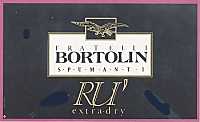
|
|
Prosecco di Valdobbiadene Extra Dry Rù |
|
| Bortolin (Veneto, Italy) | |
| Grapes: Prosecco | |
| Price: € 8.80 | Score: |
| This Prosecco di Valdobbiadene shows an pale straw yellow color and nuances of greenish yellow, very transparent, fine and persistent perlage. The nose denotes intense, clean, pleasing and refined aromas that start with hints of pear, apple and pineapple followed by aromas of hawthorn, wistaria, broom, peach and plum. The mouth has good correspondence to the nose, an effervescent and crisp attack, however balanced by alcohol, good body, intense flavors. The finish is persistent with flavors of pear, apple and plum. | |
| Food Match: Fish appetizers, Fried fish, Pasta and risotto with fish and vegetables | |
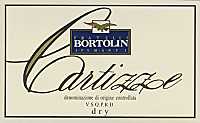
|
|
Prosecco di Valdobbiadene Superiore di Cartizze Dry |
|
| Bortolin (Veneto, Italy) | |
| Grapes: Prosecco | |
| Price: € 11.50 | Score: |
| This Prosecco di Valdobbiadene Cartizze shows a pale straw yellow color and nuances of greenish yellow, very transparent, fine and persistent perlage. The nose reveals intense, clean, pleasing and refined aromas that start with hints of pear, apple and peach followed by aromas of pineapple, broom, wistaria, lemon grass and hawthorn. The mouth has good correspondence to the nose, an effervescent and crisp attack, however balanced by alcohol, light body, intense flavors. The finish is persistent with flavors of pear, apple and peach. | |
| Food Match: Aperitifs, Vegetables and crustaceans appetizers, Pasta and risotto with vegetables and fish | |

|
|
Roero Arneis Boneur 2006 |
|
| Cascina Pellerino (Piedmont, Italy) | |
| Grapes: Arneis | |
| Price: € 7.00 | Score: |
| The wine shows an intense greenish yellow color and nuances of greenish yellow, very transparent. The nose denotes intense, clean, pleasing and refined aromas which start with hints of banana, acacia and peach followed by aromas of apple, hazelnut, grapefruit, pear, pineapple and litchi. The mouth has good correspondence to the nose, a crisp attack and however balanced by alcohol, good body, intense flavors, agreeable. The finish is persistent with flavors of banana, pineapple and peach. Roero Arneis Boneur ages in steel tanks. | |
| Food Match: Fried fish, Pasta and risotto with fish and crustaceans, Broiled crustaceans | |

|
|
Barbera d'Alba Gran Madre 2003 |
|
| Cascina Pellerino (Piedmont, Italy) | |
| Grapes: Barbera | |
| Price: € 16.00 | Score: |
| The wine shows an intense ruby red color and nuances of ruby red, moderate transparency. The nose denotes intense, clean, pleasing and refined aromas which start with hints of cherry and plum followed by aromas of violet, raspberry, blueberry, vanilla, cocoa, cinnamon and menthol. The mouth has good correspondence to the nose, a tannic attack and however balanced by alcohol, good body, intense flavors. The finish is persistent with flavors of cherry, plum and raspberry. This Barbera ages for 24 months in barrique. | |
| Food Match: Broiled meat and barbecue, Roasted meat, Braised and stewed meat, Hard cheese | |
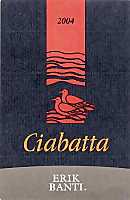
|
|
Morellino di Scansano Riserva Ciabatta 2004 |
|
| Erik Banti (Tuscany, Italy) | |
| Grapes: Sangiovese | |
| Price: € 19.00 | Score: |
| The wine shows an intense ruby red color and nuances of ruby red, moderate transparency. The nose denotes intense, clean, pleasing and refined aromas which start with hints of black cherry, plum and violet followed by aromas of blueberry, raspberry, vanilla, blackberry, pink pepper, carob and menthol. The mouth has good correspondence to the nose, a tannic attack and however balanced by alcohol, good body, intense flavors. The finish is persistent with flavors of black cherry, plum and raspberry. This wine ages for 13 months in cask. | |
| Food Match: Broiled meat and barbecue, Roasted meat, Stewed meat | |
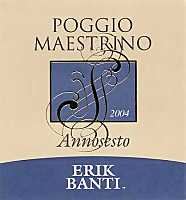
|
|
Poggio Maestrino Annosesto 2004 |
|
| Erik Banti (Tuscany, Italy) | |
| Grapes: Sangiovese Grosso (60%), Merlot (30%), Cabernet Sauvignon (10%) | |
| Price: € 25.00 | Score: |
| Poggio Maestrino Annosesto shows an intense ruby red color and nuances of garnet red, little transparency. The nose reveals intense, clean, pleasing and refined aromas that start with hints of plum and black cherry followed by aromas of violet, vanilla, blueberry, tobacco, chocolate, cinnamon, licorice, menthol and mushrooms. The mouth has good correspondence to the nose, a tannic attack and however balanced by alcohol, good body, intense flavors. The finish is persistent with flavors of plum and black cherry. This wine ages for about 1 year in steel tanks followed by 16 months of aging in barrique. | |
| Food Match: Roasted meat, Stewed and braised meat, Hard cheese | |
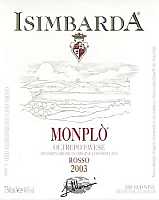
|
|
Oltrepo Pavese Rosso Monplò 2003 |
|
| Isimbarda (Lombardy, Italy) | |
| Grapes: Barbera (70%), Croatina, Moradella, Vespolina, Uva Rara (30%) | |
| Price: € 7.70 | Score: |
| This wine shows a brilliant ruby red color and nuances of ruby red, moderate transparency. The nose reveals intense, clean, pleasing and refined aromas which start with hints of black cherry, raspberry and plum followed by aromas of blueberry, violet, vanilla and cocoa. The mouth has good correspondence to the nose, a slightly tannic attack and pleasing crispness, however balanced by alcohol, good body, intense flavors. The finish is persistent with flavors of black cherry and blueberry. Oltrepo Pavese Rosso Monplò ages for some months in cask. | |
| Food Match: Broiled meat and barbecue, Roasted meat, Stewed meat | |
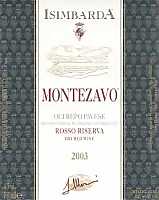
|
|
Oltrepo Pavese Rosso Riserva Montezavo 2003 |
|
| Isimbarda (Lombardy, Italy) | |
| Grapes: Barbera (70%), Croatina, Moradella, Vespolina, Uva Rara (30%) | |
| Price: € 9.50 | Score: |
| This wine shows a brilliant ruby red color and nuances of ruby red, moderate transparency. The nose reveals intense, clean, pleasing and refined aromas that start with hints of black cherry, plum and raspberry followed by aromas of violet, vanilla, strawberry, blueberry, tobacco, chocolate and menthol. The mouth has good correspondence to the nose, a tannic attack and however balanced by alcohol, good body, intense flavors. The finish is persistent with flavors of black cherry, plum and blueberry. This wine ages for 12-18 months in barrique followed by 8-12 months of aging in bottle. | |
| Food Match: Roasted meat, Braised and stewed meat, Hard cheese | |
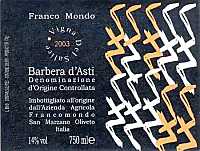
|
|
Barbera d'Asti Vigna del Salice 2003 |
|
| Franco Mondo (Piedmont, Italy) | |
| Grapes: Barbera | |
| Price: € 7.00 | Score: |
| This Barbera shows a brilliant ruby red color and nuances of ruby red, moderate transparency. The nose denotes intense, clean and pleasing aromas that start with hints of black cherry, plum and violet followed by aromas of blueberry, pink pepper and menthol. The mouth has good correspondence to the nose, a tannic attack and pleasing crispness, however balanced by alcohol, good body, intense flavors. The finish is persistent with flavors of black cherry, plum and blueberry. Barbera d'Asti Vigna del Salice ages for 7-8 months in steel tanks followed by an aging of 6 months in bottle. | |
| Food Match: Broiled meat and barbecue, Roasted meat, Braised meat | |
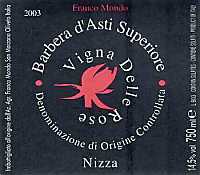
|
|
Barbera d'Asti Superiore Nizza Vigna delle Rose 2003 |
|
| Franco Mondo (Piedmont, Italy) | |
| Grapes: Barbera | |
| Price: € 12.00 | Score: |
| This Barbera shows an intense ruby red color and nuances of ruby red, little transparency. The nose reveals intense, clean, pleasing and refined aromas that start with hints of black cherry, plum and blueberry followed by aromas of violet, vanilla, tobacco, cinnamon, cocoa and menthol. The mouth has good correspondence to the nose, a tannic attack and however balanced by alcohol, good body, intense flavors. The finish is persistent with flavors of black cherry, plum and blueberry. This Barbera ages for some months in barrique. | |
| Food Match: Broiled meat and barbecue, Roasted meat, Stewed meat | |
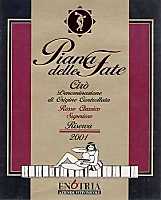
|
|
Cirò Rosso Classico Superiore Riserva Piana della Fate 2001 |
|
| Enotria (Calabria, Italy) | |
| Grapes: Gaglioppo | |
| Price: € 18.00 | Score: |
| The wine shows a brilliant ruby red color and nuances of brick red, moderate transparency. The nose reveals intense, clean, pleasing and refined aromas that start with hints of plum, black berry and carob followed by aromas of raspberry jam, vanilla, dried violet, tobacco, licorice, toffee and menthol. The mouth has good correspondence to the nose, a tannic attack and however balanced by alcohol, good body, intense flavors. The finish is persistent with flavors of plum and black cherry. This wine ages for at least one year in barrique. | |
| Food Match: Roasted meat, Braised and stewed meat, Hard cheese | |
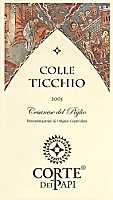
|
|
Cesanese del Piglio Colle Ticchio 2005 |
|
| Colletonno (Latium, Italy) | |
| Grapes: Cesanese | |
| Price: € 9.00 | Score: |
| This wine shows a brilliant ruby red color and nuances of ruby red, moderate transparency. The nose denotes intense, clean and pleasing aromas which start with hints of black cherry, raspberry and cyclamen followed by aromas of blueberry, strawberry and plum. The mouth has good correspondence to the nose, a slightly tannic attack and however balanced by alcohol, good body, intense flavors. The finish is pretty persistent with flavors of black cherry and raspberry. This wine ages in part in steel tanks and in part in cask. | |
| Food Match: Sauteed meat, Pasta with meat | |
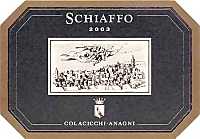
|
|
Schiaffo 2003 |
|
| Colacicchi (Latium, Italy) | |
| Grapes: Cabernet Sauvignon (45%), Merlot (35%), Cesanese d'Affile (20%) | |
| Price: € 10.80 | Score: |
| Schiaffo shows an intense ruby red color and nuances of ruby red, moderate transparency. The nose denotes intense, clean, pleasing and refined aromas which start with hints of black cherry, plum and black currant followed by aromas of violet, cyclamen, blueberry, raspberry and bell pepper. The mouth has good correspondence to the nose, a slightly tannic attack and however balanced by alcohol, good body, intense flavors. The finish is persistent with flavors of black cherry and black currant. Schiaffo ages in steel tanks. | |
| Food Match: Broiled meat and barbecue, Roasted meat, Stewed meat | |
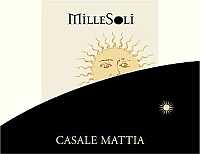
|
|
MilleSoli 2004 |
|
| Casale Mattia (Latium, Italy) | |
| Grapes: Sangiovese, Montepulciano | |
| Price: € 8.00 | Score: |
| MilleSoli shows an intense ruby red color and nuances of ruby red, little transparency. The nose denotes intense, clean and pleasing aromas which start with hints of plum and black cherry followed by aromas of violet, vanilla, carob and tobacco. The mouth has good correspondence to the nose, a tannic attack and however balanced by alcohol, good body, intense flavors. The finish is persistent with flavors of plum and black cherry. MilleSoli ages in cask for 2 years. | |
| Food Match: Roasted meat, Braised and stewed meat with mushrooms | |

|
|
Merlot Linea Storica 2004 |
|
| Casale Mattia (Latium, Italy) | |
| Grapes: Merlot | |
| Price: € 10.00 | Score: |
| This Merlot shows an intense ruby red color and nuances of garnet red, little transparency. The nose denotes intense, clean and pleasing aromas that start with hints of black cherry and plum followed by aromas of blueberry, vanilla, tobacco, carob and menthol. The mouth has good correspondence to the nose, a slightly tannic attack and however balanced by alcohol, good body, intense flavors. The finish is persistent with flavors of black cherry and plum. This Merlot ages for 12 months in barrique. | |
| Food Match: Roasted meat, Braised and stewed meat, Hard cheese | |
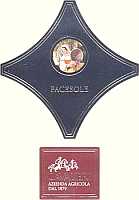
|
|
Facesole 2005 |
|
| Cavalieri (Latium, Italy) | |
| Grapes: Cesanese, Montepulciano, Cabernet Sauvignon | |
| Price: € 4.95 | Score: |
| Facesole shows a brilliant ruby red color and nuances of ruby red, moderate transparency. The nose denotes intense, clean and pleasing aromas which start with hints of cherry, raspberry and blueberry followed by aromas of strawberry, cyclamen and plum. The mouth has good correspondence to the nose, a slightly tannic attack and however balanced by alcohol, good body, intense flavors. The finish is persistent with flavors of cherry and raspberry. Facesole ages in steel tanks. | |
| Food Match: Stuffed pasta, Sauteed meat | |
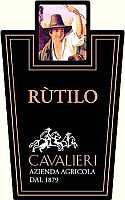
|
|
Rutilo 2004 |
|
| Cavalieri (Latium, Italy) | |
| Grapes: Cesanese, Cabernet Sauvignon, Montepulciano | |
| Price: € 9.20 | Score: |
| Rutilo shows a brilliant ruby red color and nuances of ruby red, moderate transparency. The nose reveals intense, clean, pleasing and refined aromas that start with hints of black cherry, plum and black cherry followed by aromas of raspberry, violet, vanilla, tobacco, cinnamon and carob. The mouth has good correspondence to the nose, a tannic attack and however balanced by alcohol, good body, intense flavors. The finish is persistent with flavors of black cherry and plum. Rutilo ages for 12 months in cask followed by 3 months of aging in bottle. | |
| Food Match: Broiled meat and barbecue, Roasted meat, Stewed meat | |

|
|
Porticato 2004 |
|
| Colle di Maggio (Latium, Italy) | |
| Grapes: Merlot, Cabernet Sauvignon | |
| Price: € 6.50 | Score: |
| Porticato shows an intense ruby red color and nuances of ruby red, little transparency. The nose denotes intense, clean, pleasing and refined aromas which start with hints of black cherry, plum and black currant followed by aromas of violet, vanilla, tobacco, carob and menthol. The mouth has good correspondence to the nose, a tannic attack and however balanced by alcohol, good body, intense flavors. The finish is persistent with flavors of black cherry, plum and black currant. Porticato ages for 12 months in cask followed by 6 months of aging in bottle. | |
| Food Match: Broiled meat and barbecue, Roasted meat, Stewed meat | |

|
|
Tulino 2004 |
|
| Colle di Maggio (Latium, Italy) | |
| Grapes: Syrah | |
| Price: € 11.50 | Score: |
| Tulino shows a brilliant ruby red color and nuances of ruby red, moderate transparency. The nose denotes intense, clean, pleasing and refined aromas that start with hints of black cherry, plum and black currant followed by aromas of violet, cyclamen, blueberry, raspberry, vanilla, chocolate and menthol. The mouth has good correspondence to the nose, a tannic attack and however balanced by alcohol, good body, intense flavors. The finish is persistent with flavors of black cherry, plum and blueberry. Tulino ages for 15 months in cask followed by 8 months of aging in bottle. | |
| Food Match: Broiled meat and barbecue, Roasted meat, Stewed meat | |
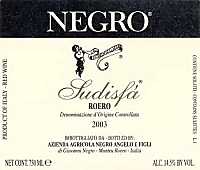
|
|
Roero Sudisfà 2003 |
|
| Negro (Piedmont, Italy) | |
| Grapes: Nebbiolo | |
| Price: € n.d. | Score: |
| Roero Sudisfà shows a brilliant ruby red color and nuances of garnet red, moderate transparency. The nose reveals intense, clean, pleasing, refined and elegant aromas which start with hints of cherry, raspberry and strawberry followed by aromas of plum, violet, vanilla, rose, tobacco, cinnamon, cocoa and menthol. The mouth has good correspondence to the nose, a tannic attack and pleasing crispness, however balanced by alcohol, full body, intense flavors. The finish is persistent with flavors of cherry, plum and raspberry. Roero Sudisfà ages for 24 months in barrique followed by about 5 months of aging in bottle. | |
| Food Match: Game, Roasted meat, Braised and stewed meat, Hard cheese | |
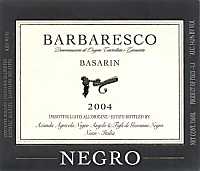
|
|
Barbaresco Basarin 2004 |
|
| Negro (Piedmont, Italy) | |
| Grapes: Nebbiolo | |
| Price: € n.d. | Score: |
| Barbaresco Basarin shows a brilliant ruby red color and nuances of garnet red, moderate transparency. The nose denotes intense, clean, pleasing, refined and elegant aromas which start with hints of cherry, plum and violet followed by aromas of cyclamen, raspberry, rose, blueberry, vanilla, tobacco, licorice, cocoa and menthol. The mouth has good correspondence to the nose, a tannic attack and pleasing crispness, however balanced by alcohol, full body, intense flavors. The finish is persistent with flavors of cherry, plum and blueberry. Barbaresco Basarin ages for 18 months in cask followed by 6 months of aging in bottle. | |
| Food Match: Game, Roasted meat, Stewed and braised meat, Hard cheese | |
|
||||||||
|
DiWineTaste Polls
|
| |||||||
Privacy Policy | |||||||


| Copyright © 2002-2024 Antonello Biancalana, DiWineTaste - All rights reserved |
| All rights reserved under international copyright conventions. No part of this publication and of this WEB site may be
reproduced or utilized in any form or by any means, electronic or mechanical, without permission in writing from DiWineTaste. |